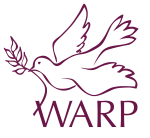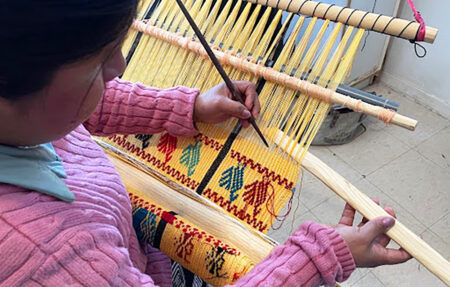by Valarie James
One day in the winter of 2021, Cecilia, a mother, a migrant, and an indigenous weaver from the mountains of Guerrero in Southern Mexico, saw an old broomstick tossed aside at the border shelter in Nogales, Sonora, Mexico. From that day on, she scoured the grounds of the shelter for sticks and broken branches, determined to build a backstrap loom with whatever she could find.
At my home in Tucson, I keep a little basket filled with old buttons, souvenirs of a life of activism. My favorite button, Art Saves Lives, brings Cecilia to mind. Families waiting at the border, desperate to apply for asylum, sometimes make the fateful decision to cross the desert on foot. Maybe Cecilia’s family won’t be one of them. Maybe Cecilia’s instinctual drive to create the art that honors the traditional work of her people, her life’s blood, will help her to hold on until border policies change. Maybe with our support, she and her children can hope for a future with less fear.
As volunteer facilitators of Tucson’s Grace St. Paul’s bi-national initiative Artisans Beyond Borders (ABB), not a day goes by that we are not awed by the instinctual human drive to create against all odds. We want to do whatever we can to support the best of humanity: art and beauty, love and hope.
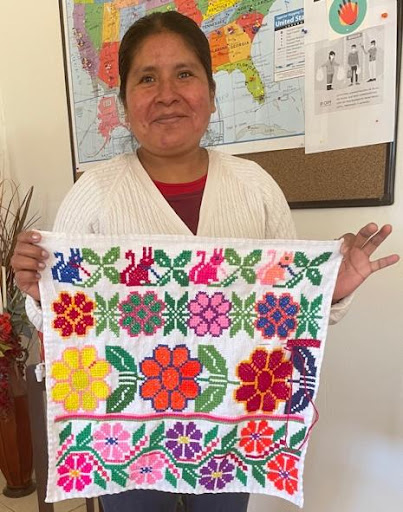
Cecilia is also an embroiderer – una bordadora. Some of the embroidered mantas she has entrusted to ABB to market show skilled needle-weaving and others are embedded with indigenous Mixtec designs. For many indigenous weavers, there is little distinction between embroidery and weaving. Both are branches of the same healthy tree of life.
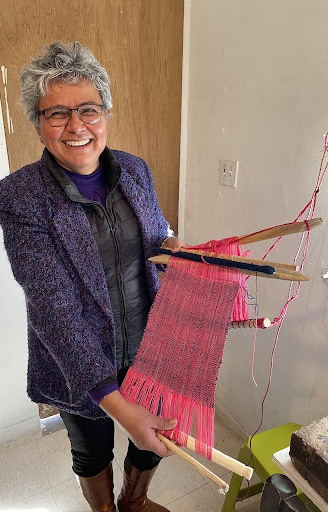

Inspired by Cecilia’s quest, volunteers and staff at la Casa de Las Misericordia shelter figured out ways to help. Sister Lika, the Director of the shelter and Ana Delia, the craft coordinator hatched a plan to help build a loom for Cecilia. ABB put out a call to the Tucson’s Hand Weavers and Spinners Guild to see if anyone might have a backstrap loom to donate. The Reverend Dr. William M. Lyons, from the United Church of Christ (UCC), part of a consortium of churches working together to support the shelter, was also inspired to help. Together, UCC and ABB purchased 2 backstrap looms from Kakaw weavers in Guatemala, one for Cecilia to have for her own and one for her to use to teach others at the shelter.
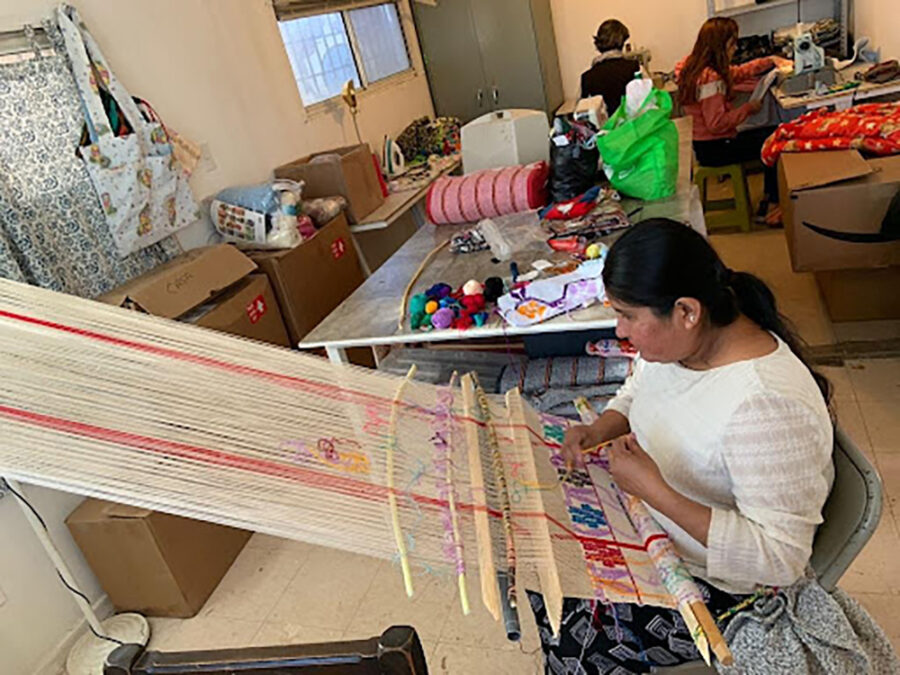
As soon as the looms arrived from Guatemala, Cecilia began to weave, while Sr. Lika and Ana Delia worked to fashion the wood for the kind of larger backstrap loom Cecilia had grown up using. Sister Lika, an accomplished artist herself, decided to try her hand at weaving and became Cecilia’s first student. Members from the Tucson Guild and the Bisbee Fiber Arts Guild donated two backstrap looms, two inkle looms and other equipment to experiment with.
Together, Cecilia and Sister Lika wove each day, warmed by the sun streaming through the small window of the shelter’s maker space that staff had recently created for the embroiderers to come in from the winter cold. I imagine the long hours waiting for asylum melting away in this space for artisans immersed in contemplative embroidery and weaving.
In just three months since Cecilia’s been able to weave again, she’s visibly changed. When we first met, she was quiet and rarely met anyone’s eyes. Now, she smiles easily and moves with confidence and agency, enthusiastically teaching, pointing out shapes and symbols that represent the lush flowers and animals of her beloved mountains. In the precious work of her hands preserving her cultural and familial arts, Cecilia feels at home at last. Grace abides in every pass of the shuttle stick through warp and weft, at la Casa de Misericordia y Todas Naciones – the House of Mercy and all Nations.
You can support these vital trauma-informed arts programs on the border with your donations to the ABB Maker Fund at: https://artisansbeyondborders.org/
Donations can also be sent directly to this shelter through: https://azdiocese.org/cruzando-fronteras/
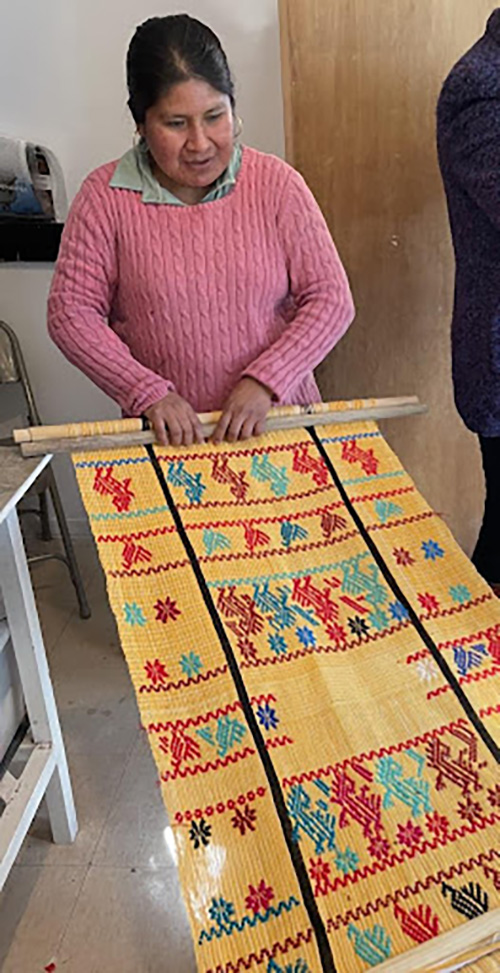
Valarie James, Founder of Artisans Beyond Borders affirms art, faith, and social justice at the U.S.-Mexico Borderlands. Her writings on arts and immigration can be found at Art and Faith in the Desert. Currently, James is the lead curator for the traveling exhibition of “Bordando Esperanza – Embroidering Hope: Devotional Retablos of Asylum.” Email for exhibition information and scheduling.
Artisans Beyond Borders was recently featured on NPR. To read or listen to the story, please click here.

Bienvenida a las tejedoras de la frontera de Estados Unidos y México
Por Valarie James
Un día de invierno en 2021, Cecilia, una madre migrante y tejedora indígena de las montañas de Guerrero en el sur de México, vio un viejo palo de escoba tirado a un lado en el refugio fronterizo en Nogales, Sonora, México. Y a partir de ese día, recorrió los terrenos del refugio en busca de palos y ramas rotas, decidida a construir un telar de cintura con lo que pudiera encontrar.
En mi casa de Tucson guardo una canastita llena de botones viejos, recuerdos de una vida de activismo. Mi botón favorito de “el arte salva vidas” me recuerda a Cecilia. Las familias que esperan en la frontera, desesperadas por solicitar asilo, a veces toman la fatídica decisión de cruzar el desierto a pie. Quizás la familia de Cecilia no sea una de ellas. Tal vez el impulso instintivo de Cecilia para crear el arte que honre el trabajo tradicional de su gente, la sangre de su vida, la ayude a aguantar hasta que cambien las políticas fronterizas. Quizás con nuestro apoyo, ella y sus hijos puedan tener la esperanza de un futuro con menos miedo.
Como facilitadores voluntarios de la iniciativa binacional “Artisans Beyond Borders” (ABB) de Grace St. Paul en Tucson, no pasa un día sin que nos asombremos por el impulso humano instintivo de crear, aunque todas las probabilidades estén en contra. Queremos hacer todo lo posible para apoyar lo mejor de la humanidad: el arte y la belleza, el amor y la esperanza.

Cecilia también es bordadora. Algunas de las mantas bordadas que ha confiado a ABB para comercializar muestran un hábil tejido con agujas y otras están incrustadas con diseños indígenas mixtecos. Para muchos tejedores indígenas, hay poca distinción entre bordado y tejido. Ambos son ramas del mismo saludable árbol de la vida.


Inspirados por la búsqueda de Cecilia, los voluntarios y el personal del albergue “La Casa de Las Misericordia” encontraron la forma de ayudar. La hermana Lika (directora del albergue) y Ana Delia (coordinadora de manualidades) idearon un plan para conseguir un telar para Cecilia. ABB pidió apoyo al gremio de tejedores e hilanderos manuales de Tucson, para ver si alguien podría donar un telar de cintura. El Reverendo Dr. William M. Lyons, de la Iglesia Unida de Cristo (UCC), que es parte de un consorcio de iglesias que trabajan juntas para apoyar el refugio, también se inspiró para ayudar. Juntos, UCC y ABB compraron 2 telares de cintura de tejedores Kakaw en Guatemala, uno para Cecilia y otro para que ella pudiera enseñar a tejer a otros en el refugio.

En cuanto llegaron los telares de Guatemala, Cecilia comenzó a tejer. Mientras la Hna. Lika y Ana Delia trabajaban para hacer un telar de cintura más grande, como el que Ana Cecilia utilizaba cuando era niña. La hermana Lika, siendo ella misma una artista, decidió comenzar a tejer y se convirtió así en la primera alumna de Cecilia. Los miembros de Tucson Guild y Bisbee Fiber Arts Guild donaron dos telares de cintura, dos telares de cinta portátiles y otras herramientas para experimentar.
Cecilia y la hermana Lika tejían juntas todos los días. Calentándose y recibiendo los rayos del sol que entraban por la pequeña ventana del espacio de creación del refugio. Espacio que el personal había creado recientemente para que las bordadoras regresaran del frío invernal. Me imagino las largas horas de espera para conseguir asilo desvaneciéndose en este espacio para artesanos, en donde la pasan inmersos en el bordado y tejido contemplativo.
El cambio de Cecilia fue visible a tan solo 3 meses de que empezara a tejer. Cuando nos conocimos, ella era muy callada y rara vez miraba a los ojos a las personas. Ahora ella sonríe fácilmente y se mueve con confianza. Enseñando con entusiasmo, y señalando las formas y símbolos que representan las exuberantes flores y animales de sus amadas montañas. Cecilia se siente por fin en casa a través del precioso trabajo que hacen sus manos. En donde preserva su arte familiar y su cultura. La gracia permanece en cada pasada de la lanzadera a través de la urdimbre y la trama en “La Casa de Misericordia y todas las Naciones.”
Pueden apoyar estos programas de arte sobre el trauma en la frontera, con sus donaciones al ABB Maker Fund en: https://artisansbeyondborders.org/
Las donaciones también se pueden enviar directamente a este albergue a través de: https://azdiocese.org/cruzando-fronteras/

Valarie James, fundadora de Artisans Beyond Borders afirma el arte, la fe y la justicia social en la frontera entre Estados Unidos y México. Sus escritos sobre el arte y la inmigración se pueden encontrar en Art and Faith in the Desert. Actualmente, James es el curador principal de la exposición itinerante “Bordando Esperanza” (Embroidering Hope: Devotional Retablos of Asylum”) Envíen un correo electrónico a: para saber más información y fechas de la exhibición.
Artisans Beyond Borders apareció recientemente en NPR. Para leer o escuchar la historia, por favor de click aquí .
